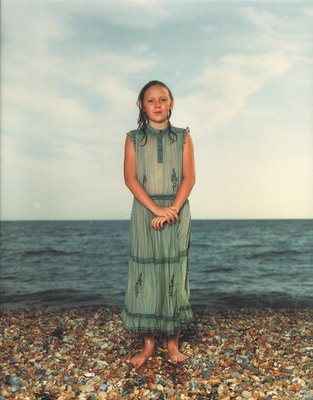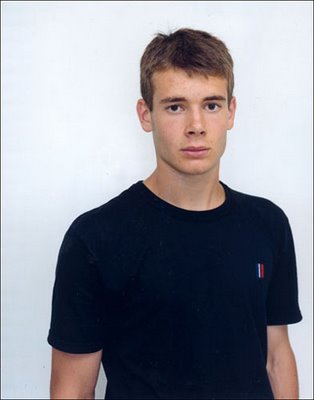Rineke Dijkstra documents people in transitional moments: mothers shortly after giving birth, young people entering the military, matadors still bloody from a bullfight, young club kids just off the dance floor, and preadolescent bathers on various beaches in the United States and Eastern Europe. Formally, her images resemble classical portraiture with their frontally posed figures isolated against minimal backgrounds. Despite their uniformity, however, Dijkstra's pictures deftly expose the emotional state of her individual sitters. Although she isolates the subjects in her Beaches series (1992–96) and frames them with only sea and sky, the artist reveals much about them by capturing a subtle gesture or expression in these unguarded moments that reside somewhere between the posed and the natural. In photographing the already awkward young subjects in their bathing suits, Dijkstra sets up a situation marked by a self-consciousness that parallels the uneasy passage between childhood and adulthood.

Kolobrzeg, Poland, 1992


Dubrovnik, 1996

Odessa, Ukraine, August 4, 1993

Evgenya Dec. 9. 2002

Olivier Silva, The Foreign Legion, Quartier Viénot, Marseille, France, July 21, 2000

Olivier Silva, The Foreign Legion, Quartier Viénot, Marseille, France, July 21, 2000

Olivier Silva, The Foreign Legion, Les Guerdes, France, November 1, 2000

Olivier Silva, The Foreign Legion, Camp Raffalli, Calvi, France, June 18, 2001
Questions-
- Why do you think Dijkstra chooses to take such a similar approach to framing all of her portrait subjects?
- The quote from the Guggenheim website claims that Dijkstra's photographs illustrate the "self-concsiousness" of her subjects. How do you think they do this?
- Why do you think Dijkstra chooses to photograph her subjects in "transitional" moments?

12 comments:
Dijkstra’s similar approach to framing her subjects is what we are familiar with. “Frontally posed figures isolated against minimal backgrounds” is what we consider portraits due to all the classical portraiture we have seen and even when we took school pictures in primary school. I think that it’s surprising that this approach, which I would normally consider boring and emotionless, can be very interesting. They are interesting because even though the subjects are fairly expressionless and the photos would be considered deadpan, you can still extract feeling and meaning. By photographing a situation that would be quite awkward, like standing in your bathing suit, and using adolescents, who normally feel awkward and self-conscious in the first place, Dijkstras photos illustrate the "self-consciousness" of her subjects. They seem self-conscious because they are not posing. Normally when someone actually strikes a pose for a picture they seem comfortable and confident with themselves and what they are doing. The subjects in the beach photographs are in the “transitional moment” of adolescence and so they are fairly self-conscious.” By photographing “transitional moments” Dijkstra places more emotion in the pictures. People can relate to the awkwardness or fear of change which occurs b/t transitional periods. Therefore, because we can relate to these transitions or similar transitions, we can assign these associated feelings and concepts from our own experiences onto a deadpan photograph. We see and abstract feeling from what the photograph reminds us of and not necessarily what the subject appears to feel.
When shooting for the "Seven Deadly Sins" project, I often found myself asking people to falsely assume a particular emotional state. Of course, this lead to some pretty horrible photographs; they looked fake. Dijkstra's deadpan approach helps her bypass this dilemma. We see her subjects in their truthful, transitional, self-conscious states. All of the subjects listed here seem to have a certain element of fear in their expressions which is telling of how all of us fear change and the future in general. This fear is what makes Dijkstra's work accessible.
Her photographs remind me of certain principles of ritual theory (where ritual is defined as a framing or marking of change). The ritual is outlined in three phases: the pre-liminal, liminal, and post-liminal stages. All of Dijkstra's subjects are on the verge of major change whether it be adulthood or military service. In the past, most artistic works were commissioned to commemorate rituals themselves or the change that results because of them. Dijkstra is unique in that she focuses on the pre-liminal stage or the time right before change. It adds a sense of uneasiness and uncertainty as we wonder what will happen to these individuals and reflect on major changes in our own lives.
Each artist is forced into making a choice of how to represent their art. the frame directs the eye to see what the artist has selected as important. Framing the individual minimizes what we see around the figure which creates a much more confrontational effect. I think that minimizing what we see puts greater emphasis on the "self-consciousness" of these subjects. with out a busy back ground the subjects appear alone, vulnerable, and aware that they are in the spotlight. i agree with Amorae about the subjects not posing adding to the self-consciousness. along with choosing what to photograph, an artist must consider how to push the boundaries without crossing them. painters create "sets" or a "series" of images that relate to each other in order to convey a particular thought. perhaps Dijkstra works with "transtional" moments to demonstrate that real life is always changing, uncomfortable, and not very glamorous.
I like the idea of focusing on a humun being right after something has happened. Its more real than if someone was to tell you to act like you just delived a baby. The only way that you would get a real shoot is if you took the shoot right after someone delived a baby!!! Dijkstra's approach with the framing of the subject is great with humuns because for a moment of time you can tell what that person is feeling.
~Brandi Ashlock
Framing each in a similar approach gives a great sense of consistency. Making each similar allows the viewer to relate one photo to the next easier. I love the way she chose to frame the people on the beach scenes. I admire each of these photos in and of themselves (mostly due to that fact the beach is one of my favorite places and I just automatically get a good feeling looking at them). But it’s the fact that these young adults are awkwardly standing there in their bathing suit that I love the most. There is something wholesome about their faces, as if you can see the youth in each of them. But, to me, there is also something unnerving about how they are barely clad in bathing suits, which takes away from their youthful purity.
While the similar framing does provide consistency, I think most of her subjects look very stiff and posed. They expressions vary, some seem indifferent, worried, frowning.. maybe self-consciousness because of the 'transitioning' shows through, or maybe they were self conscious about being made to pose, or maybe they just didnt like the way they look.
I believe that by framing all of her subjects the same way, it makes it easier for the viewer to see the differences in each subject being shown, particularly when it's the same subject being shot at different moments in their life.
These photographs illustrate the self-concsiousness of their subjects because of their stripped down nature. The person portrayed is the only thing in the frame, and this makes people feel vulnerable which shows in the pictures.
I would say that the reason Dijkstra chooses to photograph people at transitional periods in their life is because these are the interesting moments that we want to capture so that we can look back on them in the future. These are the exciting times when things are changing and emotions are running high, as opposed to the in-between times where we start to fall into a groove with the repetition of life.
-Zach Phillips
Taking pictures of people during transitions in there lives brings out the uncertainty of their future because this uncertainty seems to come across in their fascial expressions. But these photo bring out the uncertainty in the viewers life aswell because the pictures almost seem to be asking the question, "I don't what lies ahead, do you?"
Transistion is something that leaves people vulnerable and least able to cover their true self. The photographs are interesting from this stand point as they are less images of the subject than what they are feeling. You can sense the awkwardness of the teens and the developement of the soldier.
1. I'm sure Dijkstra's similar framing approach has to do with having a certain style that's preferable. Also, the particular style makes the art distinguishable.
2. I think the photographs illustrate the self-consciousness of her subjects with their facial expressions and awkward poses. Also, it is just the subjects with nothing around them. It's almost as if they were just standing there alone, doing nothing besides contemplating their own awkwardness.
3. I think she chooses to photograph her subjects in transitional moments because these ARE the most awkward moments. These are the moments we don't know how to handle yet because they are new to us. And I think she wanted to capture this.
The framing creates a story that you can follow. The choice of telling the story with the way they look after the action has happened rather than in the middle of a posed action let's the viewer create their own stories for the subjects.
Post a Comment